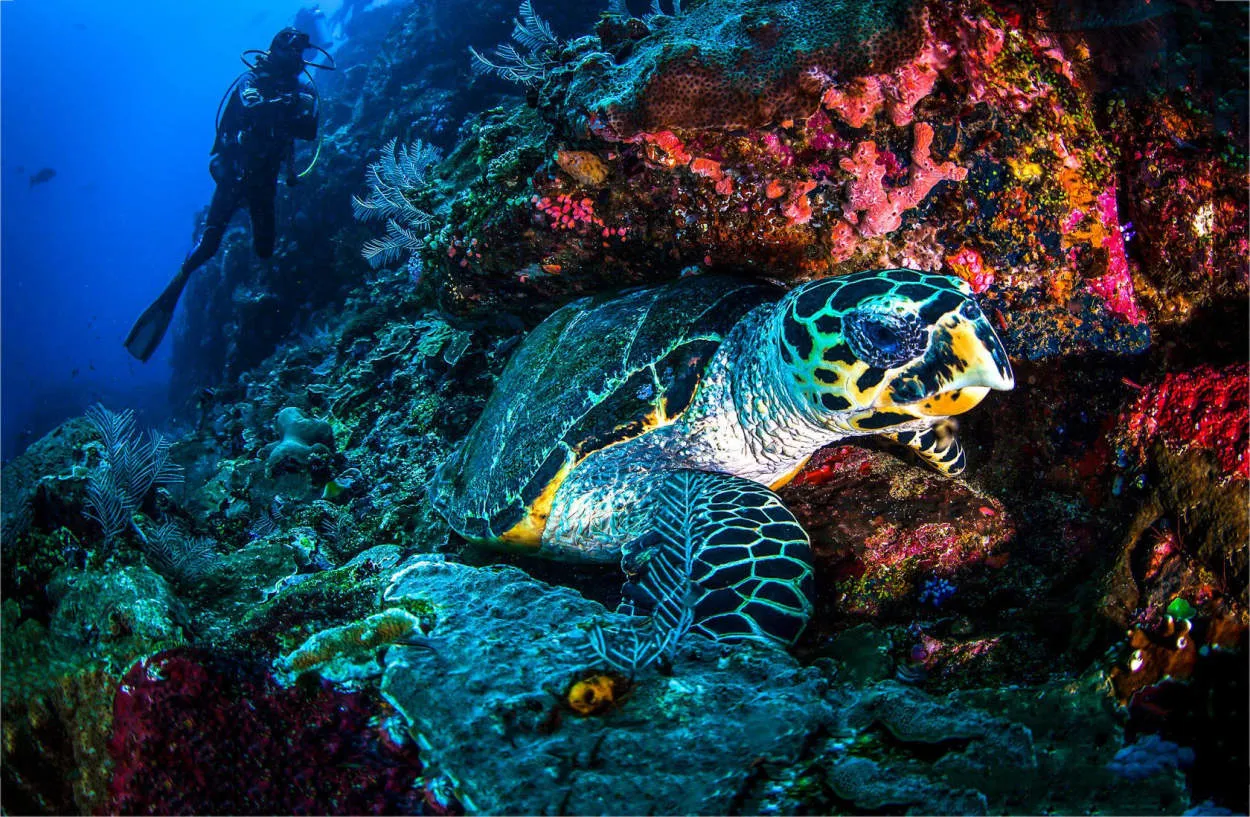The Art of Underwater Photography: A Beginner’s Guide provides a comprehensive introduction to the captivating realm of capturing images beneath the waves. Whether you’re new to photography or experienced on land, this article will help you navigate the unique challenges and techniques that come with shooting underwater.
Investing in a Suitable Underwater Camera
When it comes to underwater photography, having a suitable camera is essential to capture those breathtaking moments beneath the surface. Whether you are a beginner or a seasoned photographer, investing in the right underwater camera can make all the difference in the quality of your images.
Here are some factors to consider when choosing an underwater camera:
1. Water Resistance:
Ensure that the camera is specifically designed for underwater use and can withstand the water pressure at various depths. Look for cameras with a high waterproof rating to ensure optimal performance.
2. Image Quality:
Look for a camera that offers high resolution and excellent image quality. This will enable you to capture the vibrant colors and intricate details of the underwater world.
3. Lens Options:
Consider the different lens options that are available for the camera. Underwater photography often requires different focal lengths and wide-angle capabilities to capture the vastness of the marine environment.
4. Ease of Use:
Look for a camera that is user-friendly and easy to navigate, especially if you are a beginner. Having intuitive controls will allow you to focus on capturing the perfect shot without struggling with complex settings.
5. Durability:
Underwater conditions can be harsh, so it is important to invest in a camera that is durable and built to withstand these challenging environments. Look for cameras with strong construction and robust materials.
6. Additional Features:
Consider the additional features that the camera offers, such as image stabilization, burst mode, and manual controls. These features can enhance your photography experience and provide more creative possibilities.
Remember, underwater photography is a unique and fascinating genre that requires specific equipment to capture its beauty. By investing in a suitable underwater camera, you will be well-equipped to explore this captivating world and capture stunning images that will leave a lasting impression.
Essential Accessories for Underwater Shots
Underwater photography is a captivating art form that allows us to explore the mesmerizing world beneath the surface. Whether you are a beginner or an experienced photographer, having the right accessories can greatly enhance your underwater shots. Here are some essential accessories you should consider:
- Underwater Housing: A sturdy and waterproof housing is essential to protect your camera from the water and pressure. Make sure to choose one that is compatible with your camera model.
- Wide Angle Lens: Capturing the wide expanse of the underwater world is best achieved with a quality wide-angle lens. It allows you to include more of the surrounding environment in your shots.
- Strobe or Flash: Light dissipates quickly underwater, so using an external strobe or flash can help illuminate your subjects and bring out their vibrant colors.
- Red Filter: In deeper waters, red tones tend to fade away, resulting in a blue or green cast in your photos. A red filter compensates for this color loss and brings back the natural hues.
- Camera Tray and Arms: These accessories provide stability while shooting underwater, allowing you to capture steady shots and avoid camera shake.
- Dive Lights: If you plan to explore underwater caves or darker areas, dive lights are crucial for illuminating your subjects and creating more depth in your images.
- Float Straps: Accidents can happen, and cameras can easily slip out of your hands. Float straps keep your gear afloat, providing peace of mind and preventing any potential loss.
- Dry Bags: Protecting your equipment from water damage is essential, both during transportation and when on location. Invest in a good quality dry bag to keep your gear safe and dry.
Remember, investing in the right accessories not only improves the quality of your underwater shots but also ensures your equipment stays protected. Along with practice and patience, these essentials will assist you in capturing breathtaking moments beneath the waves.
Mastering Underwater Composition and Lighting
Underwater photography is a challenging yet rewarding field that allows photographers to capture the beauty of the underwater world. One of the key elements to master in this art form is underwater composition and lighting. By understanding and applying the principles of composition and utilizing proper lighting techniques, you can take your underwater photography to the next level.
1. Composition is key: Just like in any form of photography, composition plays a crucial role in creating captivating images. When composing your underwater shots, pay attention to elements such as symmetry, leading lines, and the rule of thirds. Experiment with different angles and perspectives to add depth and visual interest to your photos.
2. Utilize natural light: Light behaves differently underwater, and understanding how to work with it is essential. When shooting in shallower depths, make the most of available natural light by positioning yourself correctly relative to the sun. This can create beautiful rays of light or vibrant color gradients. Additionally, pay attention to the time of day, as different lighting conditions can dramatically affect the mood and atmosphere of your images.
3. Supplement with artificial lighting: In deeper depths or when shooting macro subjects, you may need to use artificial lighting to illuminate your subjects effectively. Strobes or underwater flashlights can help bring out details and prevent color loss. Experiment with different lighting techniques, such as backlighting or side lighting, to achieve different effects.
4. Understand your gear: Becoming familiar with your underwater camera gear is crucial for successful photography. Learn how to adjust settings such as aperture, shutter speed, and ISO to capture the desired exposure and depth of field. Additionally, mastering the use of filters, such as red filters for color correction, can greatly enhance your images.
5. Practice and experiment: Like any skill, mastering underwater composition and lighting takes practice. Experiment with different techniques, subjects, and environments to expand your creative horizons. Don’t be afraid to push the boundaries and try new things. Each dive presents unique opportunities, so seize them and continue refining your craft.
Tips for Capturing Vivid Colors Underwater
Underwater photography presents unique challenges and opportunities for capturing stunning and vibrant images. To make the most of your underwater photography experience, consider the following tips:
-
Choose the Right Equipment
Invest in a good-quality underwater camera or a waterproof housing for your existing camera. Ensure that your equipment is suitable for capturing vivid colors underwater.
-
Understand Lighting
Light behaves differently underwater compared to on land. To capture vibrant colors, aim to shoot during the golden hour (early morning or late afternoon), as sunlight produces warmer tones. Avoid harsh midday light, which can cause shadows and washed-out colors. Additionally, be mindful of the positioning of your light source and experiment with different lighting techniques.
-
Get Close to Your Subject
Water reduces color and contrast, so getting as close as possible to your subject will ensure better color rendition in your photos. Consider using wide-angle lenses or macro lenses to bring out the details and colors of small marine life.
-
Maintain a Colorful Composition
Include colorful elements such as corals, fish, or vibrant backgrounds in your frame to make your photos visually appealing. Pay attention to color combinations and contrast to create dynamic and eye-catching compositions.
-
Use Manual White Balance
Adjusting the white balance settings on your camera can help eliminate the blue or green cast often found in underwater photos. Experiment with different white balance settings or shoot in RAW format for more post-processing flexibility.
-
Edit with Care
In post-production, you can enhance the colors and contrast of your underwater photos using photo-editing software. Be cautious not to overdo it, as excessive editing can make the image look unrealistic.
By following these tips, you can improve your chances of capturing vivid and captivating underwater photographs. With practice and experimentation, you’ll develop your own unique style as an underwater photographer.
Conclusion
In conclusion, underwater photography is a captivating art form that requires careful preparation, technical knowledge, and a keen eye for details. By following the tips and techniques discussed in this beginner’s guide, aspiring underwater photographers can begin to capture breathtaking images of the underwater world. With practice and dedication, this unique form of photography can become a rewarding and fulfilling creative outlet.




